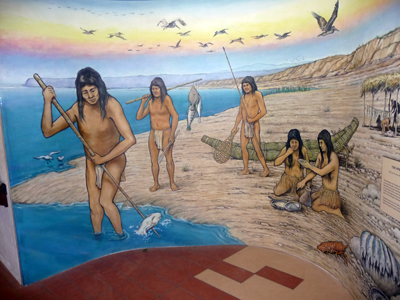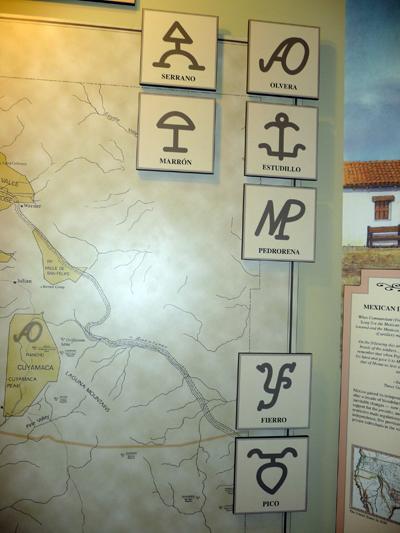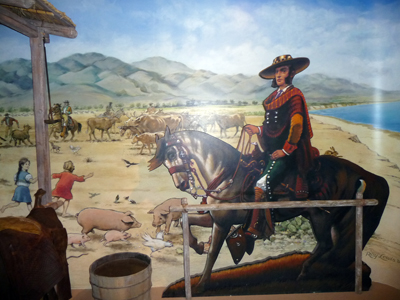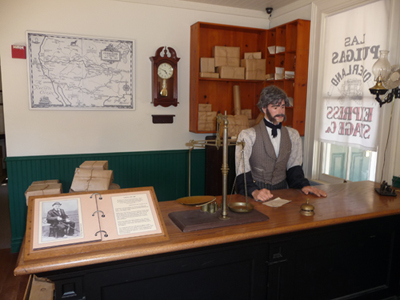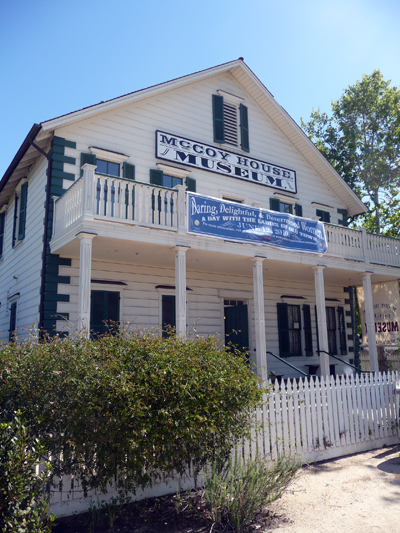
By Donald H. Harrison

SAN DIEGO – Thanks to fictionalized accounts of the lives of “lawmen” in the Old West, many people have romanticized notions about what it was like to be the sheriff in a frontier town. Probably a front parlor in a two-story Greek revival home where the children played the piano and recited poetry for visitors doesn’t fit the stereotype.
In Old Town San Diego State Historic Park, one may wonder if one is seeing the “real McCoy” upon stepping into the McCoy House built in 1869 for Sheriff and Mrs. James and Winifred McCoy.
The frontier sheriff is described in a wall-mounted narrative as having been “an influential Irish-born politician of the Democratic party” who built the home as a wedding present for the former Winifred Kearney of Los Angeles.
The house was reconstructed in 2000 to create an interpretive center for the state park. Although the front parlor is furnished with artifacts of the period, none of them was actually McCoy’s. Rather, the furnishings represent best guesses by California historians of what a parlor of an upper middle class family in San Diego in the late 19th century might have contained.
The docent told of a time in old San Diego when to improve the production of pork, farmers decided to import a prize sow, which was named Elizabeth. When the animal finally arrived, “they paraded her up from the harbor and up San Diego Avenue with a big brass band, “ Wolfing said. “They introduced her to a local boar and sure enough they started producing piglets.” The problem was that the piglets started disappearing from their pens.
So, the pens were moved near a home where they could be watched from the window. One night, hearing some person near the pig pen, a guard shot out the window, killing an Indian. As pig-stealing was not considered a capital crime, the person who fired the shot was put on trial for murder. A jury deliberated the evidence, but before members could return to the court, Sheriff McCoy asked them what verdict they had decided. “Guilty—guilty as sin,” Wolfing quoted the foreman as having replied.
According to the docent’s account: “McCoy shakes his head, saying, ‘I think you need to think more about this!’ He came back two other times and he wouldn’t let them out until they came back with a verdict of ‘Not Guilty.’ McCoy just couldn’t see punishing a white man for shooting a pig-stealing Indian!”
My own research for the biography, Louis Rose: San Diego’s First Jewish Settler and Entrepreneur found that McCoy like many San Diegans of the period had speculated in land on the hope that San Diego would become the western terminus of the nation’s southernmost transcontinental railroad. McCoy served on the board of directors of the San Diego and Gila Railroad company, which had no tracks nor rolling stock but nevertheless had acquired rights to vast tracts of land in San Diego to be used as enticement for the Texas and Pacific Railroad to build its line from Marshall, Texas, to San Diego.
When Congress authorized such a route in 1871, private property values skyrocketed, including in Roseville – the bayside town laid out by Louis Rose—on the theory that there was no better location for a railroad than near where ocean-going ships had docked. McCoy purchased several lots in Roseville, but the town’s prospects for a terminus—as well as those for competing areas elsewhere in San Diego—went bust. This was because the railroad company decided the terrain east of San Diego was too rugged, and decided instead upon Los Angeles as the west coast terminus.
The McCoy House is quite close to the Old Town terminal of the San Diego Trolley – a factor in the decision to use it as an interpretive center. It is the first building in the state park that one sees when arriving by trolley.
From the parlor, a visitor is led through a historic maze within the house. The route takes one through exhibits about the Kumeyaay Indians; the Spanish explorers and colonizers; the Californio ranchers and their seafaring Yankee trading partners; and finally to exhibits about the early American times in which McCoy himself participated.
Murals and dioramas depicting different aspects of life in these periods—as well as well-researched wall narratives accompanied by an array of interesting artifacts – makes this walk through San Diego history an interesting and worthwhile experience.
While close to the trolley at the western end of the park, the McCoy House is somewhat removed from the central plaza to which most tourists flock. Consequently its visitor count is lower than at other Old Town San Diego State Park attractions such as the Casa de Estudillo, Mason Street School, Wells Fargo Museum, City Hall and Little Jail. This is unfortunate because if tourists knew to find the McCoy House exhibits, these visitors would benefit from the context these exhibits provide for the other museums and historic commercial venues.
Following are photographs of some of the exhibits:
